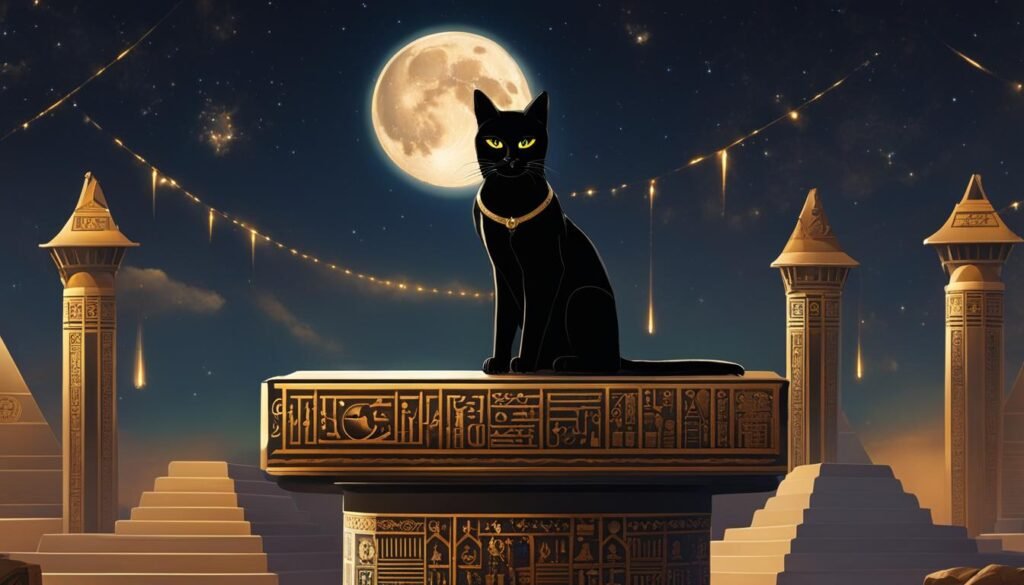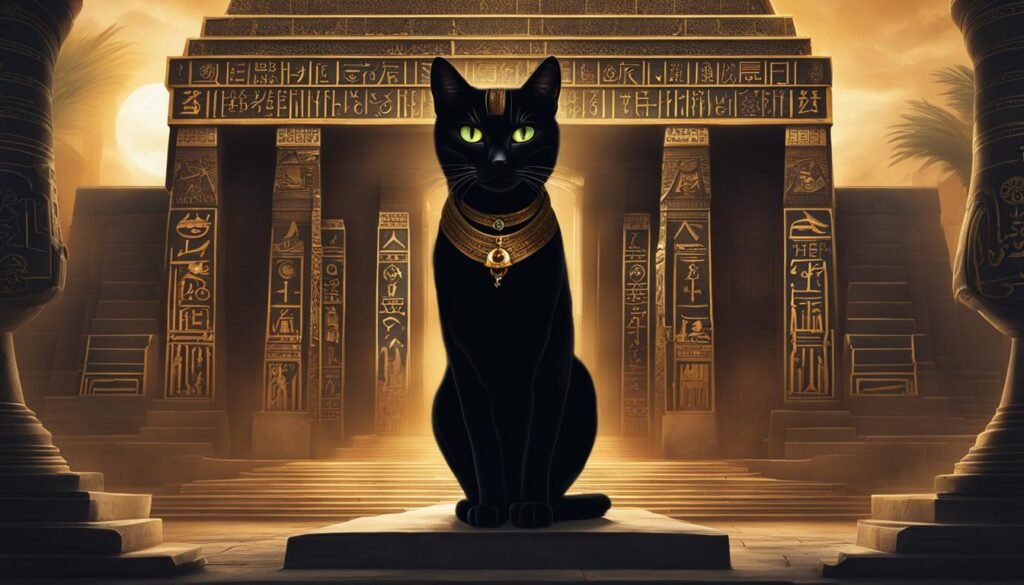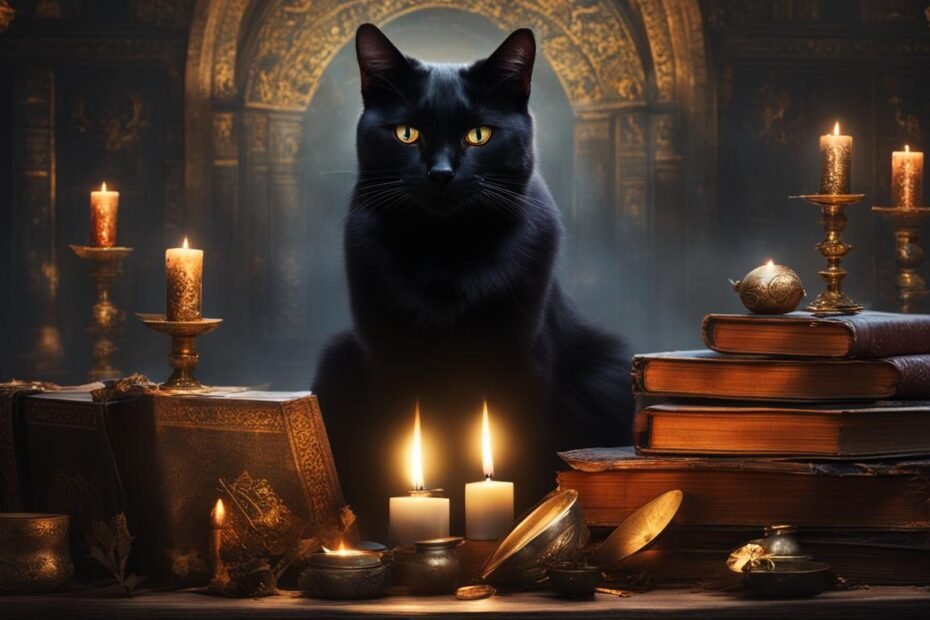Welcome to our fascinating journey into the world of cat folklore mythology! Cats have been enchanting humans for centuries with their mysterious and alluring presence. In this article, we will delve into the mythical realm of these legendary creatures and uncover the captivating tales, beliefs, and symbolism surrounding cats in various cultures.
Cultural myths and folklore stories about cats have been passed down through generations, weaving a tapestry of cat symbolism and meaning. From ancient civilizations to modern times, cats have played significant roles in shaping our cultural beliefs and spiritual practices.
Key Takeaways:
- Cat folklore mythology explores the symbolic meanings and cultural significance of cats throughout history.
- Mythical cats have been revered in various cultures and associated with qualities such as elegance, curiosity, and protection.
- Legendary cats have played important roles in mythology and folklore, embodying divine attributes.
- Folklore stories about cats are rich in symbolism, reflecting the human fascination with these enigmatic creatures.
- Cultural myths surrounding cats have influenced our perception of these animals and shaped our cultural beliefs.
Cat Symbolism: Exploring the Spiritual Meanings of Felines
Throughout history, cats have been revered for their symbolic meanings and spiritual significance. These enigmatic creatures embody a range of qualities that have captivated human imagination for centuries.
Cats are often associated with elegance and grace, symbolizing a sense of poise and beauty. Their sleek movements and regal demeanor inspire us to embrace these qualities in our own lives. Curiosity is another notable characteristic of cats, reminding us to approach life with a sense of wonder and adventure.
“The cat could very well be man’s best friend but would never stoop to admitting it.”
Cats also represent independence and the importance of maintaining our individual identities. They roam freely, unencumbered by the constraints of society, teaching us the value of self-reliance. Furthermore, cats are often regarded as spirit animals, believed to possess unique spiritual qualities and connections to realms beyond our own.
The Many Facets of Cat Symbolism
The symbolism of cats extends beyond their physical presence. In mythology and folklore from various cultures, cats are associated with magic and mysticism. They are believed to possess spiritual powers, acting as protectors and guides in spiritual practices and rituals.
| Mythology | Region | Symbolic Meaning |
|---|---|---|
| Ancient Egypt | Egypt | Protection, home, and fertility |
| Greek | Greece | Independence and cunning |
| Celtic | Ireland | Guardians of the Otherworld, prophetic abilities |
| Norse | Scandinavia | Guides of the goddess Freyja, associated with love and beauty |
| Hindu | India | Linked to goddesses such as Durga |
| Japanese | Japan | Bringers of good luck and fortune |
The diverse interpretations of cat symbolism in different cultures highlight the significance of these feline creatures throughout history.

In conclusion, cats hold a special place in our cultural beliefs and collective imagination due to their rich symbolism. From elegance and curiosity to independence and spiritual connections, cats embody a range of qualities that inspire and intrigue us. By delving into their mythology and folklore, we can gain a deeper understanding of the profound impact that cats have had on our cultural narrative.
Cat Mythology and Folklore
Cats have a rich mythology and folklore associated with them in different cultures. These fascinating creatures have held symbolic meanings and played significant roles in various mythologies and belief systems throughout history.
Ancient Egypt
In ancient Egypt, cats were highly revered and considered sacred beings. They were associated with the goddess Bastet, the goddess of home, fertility, and protection. Cats were believed to embody the qualities of the goddess and were considered guardians of the home. Ancient Egyptians believed that by owning a cat, they would receive the blessings and protection of Bastet. In fact, harming or killing a cat was considered a grave offense punishable by law.
Greek Mythology
In Greek mythology, cats were associated with the goddess Artemis. Known for her independence and fierce hunting abilities, Artemis was often depicted with cats. Cats symbolized the qualities of independence, agility, and cunning, which were attributes associated with the goddess herself.
Celtic Mythology
In Celtic mythology, cats were considered to be guardians of the Otherworld. They were believed to have the ability to travel between realms and were associated with witchcraft and magic. Cats were seen as mysterious creatures with prophetic abilities, capable of seeing beyond the veil of reality.
Norse Mythology
In Norse mythology, the goddess Freyja was known to have a chariot pulled by two large cats. These cats represented the mystical and magical nature of the goddess, and their strength and grace were believed to be a reflection of Freyja herself.
Hinduism, Japan, and Christianity
Cats have also found their place in other mythologies and belief systems. In Hinduism, cats are associated with goddesses such as Durga, who represents power and protection. In Japan, cats are seen as bringers of good luck and fortune, as represented by the popular Maneki-neko charm. In Christianity, cats have both positive and negative associations. While they have been depicted as protectors and companions, they have also been associated with witchcraft and darkness.
| Mythology | Symbolism |
|---|---|
| Ancient Egypt | Sacredness, protection, blessing |
| Greek Mythology | Independence, agility, cunning |
| Celtic Mythology | Guardians of the Otherworld, prophecy, magic |
| Norse Mythology | Mystical, magical, reflection of goddess |
| Hinduism | Power, protection |
| Japan | Good luck, fortune |
| Christianity | Protector, companion, witchcraft associations |
The Enigma of Three-Eyed Cats: Myth and Reality
Three-eyed cats have fascinated humanity for centuries, with their unique appearance and mystical symbolism. Ancient beliefs attributed deep significance to these peculiar felines, associating them with heightened intuition, psychic abilities, and divine blessings. In various cultures, three-eyed cats have been revered as symbols of good luck, prosperity, and spiritual powers.
While the existence of three-eyed cats has been documented throughout history, science offers an explanation rooted in genetic mutations and anomalies that affect eye development. These genetic variations can lead to the formation of a third eye, which captivates our imagination and fuels speculation about its spiritual significance.
The concept of the third eye holds spiritual significance in many belief systems, often associated with the pineal gland. However, the exact role of the pineal gland in spiritual experiences remains a topic of ongoing scientific debate. Nonetheless, the allure of three-eyed cats persists, as their enigmatic presence continues to inspire wonder and belief.

Quotes
“The third eye on a cat represents heightened intuition and psychic abilities, a divine sign.” – Ancient Egyptian belief
“Three-eyed cats symbolize good luck, prosperity, and spiritual powers in Asian cultures.” – Asian folklore
Table: Symbolism of Three-Eyed Cats
| Symbol | Meaning |
|---|---|
| Intuition | Third eye represents heightened intuition and psychic abilities. |
| Divine Blessing | Presence of a three-eyed cat is considered a sign of divine favor. |
| Good Luck | Believed to bring luck, prosperity, and abundance. |
| Spiritual Powers | Associated with mystical and spiritual abilities. |
As we navigate the realms of myth and reality surrounding three-eyed cats, their symbolism continues to captivate our imagination. While scientific explanations shed light on genetic mutations, the spiritual significance attached to these mysterious felines sustains our fascination and invites contemplation of the extraordinary.
Conclusion
The world of cat folklore mythology is a captivating realm that unveils the symbolic meanings and cultural significance of these enchanting creatures throughout history. From the ancient civilizations of Egypt and Greece to the spiritual practices of Hinduism and Christianity, cats have held a prominent place in our collective imagination.
Cats are revered for their elegance, curiosity, and independent nature, embodying qualities that inspire us to embrace a life of grace and adventure. They have played significant roles in mythology and folklore, symbolizing companionship, protection, and magic. Cats have been associated with goddesses, guardians of the Otherworld, and even as bringers of good luck and fortune.
One particularly intriguing aspect of cat mythology is the enigma of three-eyed cats. Although scientific explanations attribute this phenomenon to genetic mutations, the spiritual significance attached to these mystical creatures continues to captivate our imaginations. Their third eye represents heightened intuition and psychic abilities, evoking a sense of divine blessings and spiritual powers.
In conclusion, the rich tapestry of cat folklore mythology offers profound insights into ancient beliefs and the enduring cultural fascination with these mysterious creatures. Cats hold a special place in our hearts and continue to ignite a sense of wonder and awe. Whether as protectors, guides, or embodiments of magic, cats will forever be cherished as symbols of grace, curiosity, and the timeless bond between humans and animals.
FAQ
What do cats symbolize?
Cats symbolize elegance, curiosity, independence, protection, magic, and good luck.
What is the significance of cats in mythology and folklore?
Cats have a rich mythology and folklore associated with them in various cultures, including ancient Egypt, Greek mythology, Celtic mythology, Norse mythology, Hinduism, Japan, and Christianity.
What is the symbolism behind three-eyed cats?
In ancient beliefs, the third eye on a cat represented heightened intuition and psychic abilities. Three-eyed cats are also seen as symbols of good luck, prosperity, and spiritual powers in Asian cultures.
What is the scientific explanation for three-eyed cats?
Genetic mutations and anomalies can lead to abnormal eye development in cats, including the presence of a third eye.
What is the spiritual significance of three-eyed cats?
The spiritual significance of three-eyed cats is associated with the concept of the third eye, which is believed to be linked to intuition and spiritual experiences. However, there is ongoing debate among scientists about the role of the third eye in spiritual practices.
Why are cats considered symbols of elegance and curiosity?
Cats are seen as graceful and self-contained creatures that inspire us to embrace elegance in our lives. Their curiosity and inclination for mischief remind us to embrace adventure and shake up our routines.
